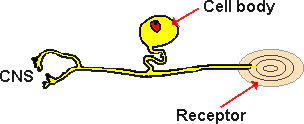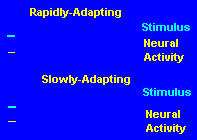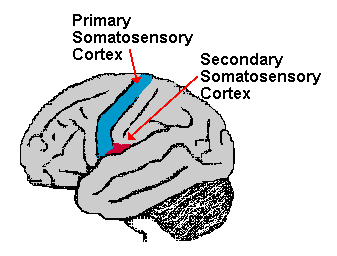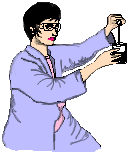|
1. Skin can detect several types of
sensations
Information from our skin allows us to identify several distinct types of
sensations, such as tapping, vibration, pressure, pain, heat, and cold.
 What is
it that allows us to make these distinctions? First, human skin contains
different kinds of sensory receptors (cells) that respond preferentially
to various mechanical, thermal, or chemical stimuli. (The word "receptor"
can mean a receptor cell or a membrane receptor in a cell. Here, it
refers to a cell.) Next, these receptors convey this information to the
brain and spinal cord, also known as the central nervous system
(CNS), to areas where we perceive the stimuli. To accomplish
this,
the nerve endings of the sensory receptors transduce, or convert,
mechanical, thermal, or chemical energy into electrical signals. These
electrical signals then travel along neuronal extensions called
axons, to the CNS. Finally, the way we
interpret or understand sensations is shaped not only by the properties of
receptors and neurons, but also by previous experiences that are stored in
our brains. What is
it that allows us to make these distinctions? First, human skin contains
different kinds of sensory receptors (cells) that respond preferentially
to various mechanical, thermal, or chemical stimuli. (The word "receptor"
can mean a receptor cell or a membrane receptor in a cell. Here, it
refers to a cell.) Next, these receptors convey this information to the
brain and spinal cord, also known as the central nervous system
(CNS), to areas where we perceive the stimuli. To accomplish
this,
the nerve endings of the sensory receptors transduce, or convert,
mechanical, thermal, or chemical energy into electrical signals. These
electrical signals then travel along neuronal extensions called
axons, to the CNS. Finally, the way we
interpret or understand sensations is shaped not only by the properties of
receptors and neurons, but also by previous experiences that are stored in
our brains.
In this lab, activities involve the tactile or touch sense of the
skin, which allows us to distinguish different kinds of stimuli upon the
surface of the body. By using our tactile sense, we detect superficial
and deep pressure and sensations we describe as brushing, vibration,
flutter, and indentation. As mentioned above, our skin is also sensitive
to temperature and pain, which we sense with different sets of receptors.
These
skin senses, along with muscle/joint position awareness or proprioception,
make up the somatic senses.
2. Sensory information forms the basis for our
connection to the outside world
How do we use somatic sensory information? Brainstorm with students for
ideas and see if they include the following: exploring, evaluating, and
enjoying our environment; making decisions about what to
wear or where to set the thermostat; keeping ourselves awake and alert;
using as feedback for controlling our movements; avoiding harm from hot,
cold, or damaging substances. (Note that some of these involve the tactile
sense while others involve the pain, temperature, and proprioceptive
senses.) The somatic senses and the sense of taste put us in direct
contact with our environment, while vision, hearing, and smell gather
information from a distance. Other special internal senses include
balance, detecting blood pressure, and sensing blood oxygen levels.
3. Different kinds of tactile receptors respond
to distinct types of information  The tactile system,
which is activated in the two-point discrimination test, employs several
types of receptors. A tactile sensory receptor can be
defined as
the peripheral ending of a sensory neuron and its accessory structures,
which may be part of the nerve cell or may come from epithelial or
connective
tissue. Different kinds of receptors respond to different kinds
of
stimulation, such as vibration, pressure, or tapping, and convert these
into electrical signals. Table 1 below shows a few types of skin
receptors, the kinds of input they detect, and their adaptation
rate when stimulated. Slowly adapting receptors continue sending
impulses to the brain for a relatively long time when a constant stimulus
is applied. Rapidly adapting receptors fire at the time a stimulus begins
and sometimes again when it is removed, but they do not continue firing to
a constant stimulus. Having receptors with different preferences and
different "reporting" capabilities allows us to tune in more acutely to
our environment and to distinguish a wide variety of sensations. The tactile system,
which is activated in the two-point discrimination test, employs several
types of receptors. A tactile sensory receptor can be
defined as
the peripheral ending of a sensory neuron and its accessory structures,
which may be part of the nerve cell or may come from epithelial or
connective
tissue. Different kinds of receptors respond to different kinds
of
stimulation, such as vibration, pressure, or tapping, and convert these
into electrical signals. Table 1 below shows a few types of skin
receptors, the kinds of input they detect, and their adaptation
rate when stimulated. Slowly adapting receptors continue sending
impulses to the brain for a relatively long time when a constant stimulus
is applied. Rapidly adapting receptors fire at the time a stimulus begins
and sometimes again when it is removed, but they do not continue firing to
a constant stimulus. Having receptors with different preferences and
different "reporting" capabilities allows us to tune in more acutely to
our environment and to distinguish a wide variety of sensations.
TABLE 1
Characteristics of sensory receptors in the
skin |
| Receptor | Stimulus | Sensation
| Adaptation | | Merkel's disk | Steady
indentation | Pressure | Slow | | Meissner's
corpuscle | Low frequency vibration | Gentle
fluttering | Rapid | | Ruffini's
corpuscle | Rapid indentation | Stretch | Slow |
| Pacinian
corpuscle | Vibration | Vibration | Rapid |
| Hair receptor | Hair
deflection | Brushing | Rapid or
Slow |
The Skin
4. Sensory input is "mapped" onto specific
brain areas
 Information from each skin receptor is carried along a pathway formed by
several neuronal axons to a strip on the top of the brain surface called
the somatosensory cortex. The cortex or "rind"
is the cell body-containing outer layer of the brain and is about six
millimeters, or one-quarter inch, thick. The somatosensory cortex is
packed with the cell bodies of CNS neurons, which receive "skin input"
from all parts of the body via the "touch-neuron pathway."
Information from each skin receptor is carried along a pathway formed by
several neuronal axons to a strip on the top of the brain surface called
the somatosensory cortex. The cortex or "rind"
is the cell body-containing outer layer of the brain and is about six
millimeters, or one-quarter inch, thick. The somatosensory cortex is
packed with the cell bodies of CNS neurons, which receive "skin input"
from all parts of the body via the "touch-neuron pathway."
Sensory input pours into the CNS neurons in a topographically faithful
manner. This means, for instance, that the CNS neurons receiving input
from sensory receptors in the right thumb will have neighbor cells that
receive input from the right index finger. These, in turn, will have
neighbors receiving input from the next finger, and so on. In this way, a
sensory "map" of the body surface is created on a section of the brain
surface. Neurologists discovered this years ago when they found that they
could produce the illusion of sensation in, say, a finger, by electrically
stimulating the appropriate spot on the somatosensory cortex: the CNS
neurons interpreted the artificial electrical stimulus as input coming
from the finger that usually sent it information.
From the somatosensory cortex, messages about sensory input are sent to
other brain areas; for example, to motor areas for use in performing
actions, and to higher processing areas, for making decisions or enjoying
sensations or reflecting on them.
5. Sensory maps in the cortex are "distorted"
Although tactile sensory maps in the cerebral cortex are faithful to the
locations of the sensory receptors, they do not reflect the correct
proportions of the skin areas. Rather, the cortical area devoted to
receiving information from a spot on the skin reflects the density of
sensory receptors there, and this number in turn reflects the importance
of that body area for gathering information. The fingertips, for example,
contain about 100 times more receptors per square centimeter than the skin
on the back. Because of this, more CNS neurons must be devoted to
receiving fingertip sensations, and consequently the cortical area that
receives input from the fingertips is huge compared to the area that
receives input from skin on the back.
If pictures of the parts of the body are drawn next to their corresponding
brain areas, the fingers are very large and the arms and back are small.
This type of picture is called a homunculus, literally,
"little man" or person.

All sensory systems feed information into the cerebral cortex in orderly
maps, even though the other peripheral sensory receptors, unlike those of
the touch or tactile system, are concentrated in small organs: eyes, ears,
nose, and tongue. Information from each of these senses is mapped onto a
different brain area.
6. Receptor density and the
sizes of receptive fields of central neurons determine
two-point discrimination ability
What properties of the touch sensory system allow us to discriminate two
points pushing on our skin even when they are only 2 or 3 mm apart? One
of the necessary properties is high receptor density, and the class should
discuss this after students find that the two-point threshold distance on
the fingertips is two to three millimeters (mm). In other words, the
receptors must be packed closely enough so that a probe stimulates one
or more of them. High receptor density alone, however, cannot explain
why the fingertip can distinguish points so close together while the arm
senses two points only when they are 35 to 40 mm apart. The second
property necessary for fine two-point discrimination is that neighboring
receptors must connect to different CNS neurons, which in turn means that
these CNS neurons must have small receptive fields, as explained below.
Each sensory receptor connects through a series of relay neurons with
a CNS neuron. A given central neuron responds to all information from its
input area (the skin area that is the gathering field for only
that CNS cell) as if it were coming from one point. This skin area is
called the receptive field of the central neuron. On
the arm, each sensory receptor gathers information from a much larger skin
area than a receptor on the fingertip, and this receptor is also connected
to a defined central neuron. This central neuron, like the central
"finger neuron", interprets all input as coming from one point, even
though the skin area in this case is much larger. In order for a
person to feel two points, two separate central neuronal populations must
be activated by stimulation of their respective receptive fields. When
this happens, two points are reported.
To summarize, two-point discrimination depends on
activating two separate populations of neurons, and in order to
discriminate two closely placed points, the receptive fields of the
neurons must be small. This in turn means that the receptors must be
densely packed in a sensitive area, so that two points very close together
activate different receptors.
7. Sensory information from different receptors
is combined at higher brain levels
Although individual receptors respond to only one type of stimulus, such
as pressure or vibration, a stimulus in the real world almost always
activates several kinds of receptors simultaneously.
To form a representative picture of this in our minds, the different
sensations must all "get together" somewhere in the brain, and one place
this happens is in cortical neurons called feature-detecting neurons.
These neurons each receive several different types of information from
neurons in the primary somatosensory cortex (which received their
information
from receptors). This integration of sensations allows us to experience an
ice cube as both smooth and cold, or to feel that sand at the beach
contains different sized grains and may be hot or cool. As this
information is sent to higher brain centers, sensations also take on
meaning because of past experiences.
8. Neurologists use two-point
discrimination tests to check for nerve damage
Neurologists, doctors who specialize in diseases of the central (brain and
spinal cord) and peripheral (nerves to all the organs and muscles) nervous
systems, sometimes test patients for two-point discrimination. They may do
this if they suspect a problem with sensory information entry to the skin,
the pathways to the brain, or the interpretation of sensory information.
For example, if a patient has cut a finger badly, a neurologist may test
for two-point discrimination at the time of injury to see if the nerve was
cut. After the original injury has healed for a number of weeks, the
neurologist will again test two-point discrimination and compare it with
the normal fingers to see if the nerve has regenerated.
|






 What is
it that allows us to make these distinctions? First, human skin contains
different kinds of sensory receptors (cells) that respond preferentially
to various mechanical, thermal, or chemical stimuli. (The word "receptor"
can mean a receptor cell or a membrane receptor in a cell. Here, it
refers to a cell.) Next, these receptors convey this information to the
brain and spinal cord, also known as the central nervous system
(CNS), to areas where we perceive the stimuli. To accomplish
this,
the nerve endings of the sensory receptors transduce, or convert,
mechanical, thermal, or chemical energy into electrical signals. These
electrical signals then travel along neuronal extensions called
axons, to the CNS. Finally, the way we
interpret or understand sensations is shaped not only by the properties of
receptors and neurons, but also by previous experiences that are stored in
our brains.
What is
it that allows us to make these distinctions? First, human skin contains
different kinds of sensory receptors (cells) that respond preferentially
to various mechanical, thermal, or chemical stimuli. (The word "receptor"
can mean a receptor cell or a membrane receptor in a cell. Here, it
refers to a cell.) Next, these receptors convey this information to the
brain and spinal cord, also known as the central nervous system
(CNS), to areas where we perceive the stimuli. To accomplish
this,
the nerve endings of the sensory receptors transduce, or convert,
mechanical, thermal, or chemical energy into electrical signals. These
electrical signals then travel along neuronal extensions called
axons, to the CNS. Finally, the way we
interpret or understand sensations is shaped not only by the properties of
receptors and neurons, but also by previous experiences that are stored in
our brains. The tactile system,
which is activated in the two-point discrimination test, employs several
types of receptors. A tactile sensory receptor can be
defined as
the peripheral ending of a sensory neuron and its accessory structures,
which may be part of the nerve cell or may come from epithelial or
connective
tissue. Different kinds of receptors respond to different kinds
of
stimulation, such as vibration, pressure, or tapping, and convert these
into electrical signals. Table 1 below shows a few types of skin
receptors, the kinds of input they detect, and their adaptation
rate when stimulated. Slowly adapting receptors continue sending
impulses to the brain for a relatively long time when a constant stimulus
is applied. Rapidly adapting receptors fire at the time a stimulus begins
and sometimes again when it is removed, but they do not continue firing to
a constant stimulus. Having receptors with different preferences and
different "reporting" capabilities allows us to tune in more acutely to
our environment and to distinguish a wide variety of sensations.
The tactile system,
which is activated in the two-point discrimination test, employs several
types of receptors. A tactile sensory receptor can be
defined as
the peripheral ending of a sensory neuron and its accessory structures,
which may be part of the nerve cell or may come from epithelial or
connective
tissue. Different kinds of receptors respond to different kinds
of
stimulation, such as vibration, pressure, or tapping, and convert these
into electrical signals. Table 1 below shows a few types of skin
receptors, the kinds of input they detect, and their adaptation
rate when stimulated. Slowly adapting receptors continue sending
impulses to the brain for a relatively long time when a constant stimulus
is applied. Rapidly adapting receptors fire at the time a stimulus begins
and sometimes again when it is removed, but they do not continue firing to
a constant stimulus. Having receptors with different preferences and
different "reporting" capabilities allows us to tune in more acutely to
our environment and to distinguish a wide variety of sensations.
 Information from each skin receptor is carried along a pathway formed by
several neuronal axons to a strip on the top of the brain surface called
the somatosensory cortex. The cortex or "rind"
is the cell body-containing outer layer of the brain and is about six
millimeters, or one-quarter inch, thick. The somatosensory cortex is
packed with the cell bodies of CNS neurons, which receive "skin input"
from all parts of the body via the "touch-neuron pathway."
Information from each skin receptor is carried along a pathway formed by
several neuronal axons to a strip on the top of the brain surface called
the somatosensory cortex. The cortex or "rind"
is the cell body-containing outer layer of the brain and is about six
millimeters, or one-quarter inch, thick. The somatosensory cortex is
packed with the cell bodies of CNS neurons, which receive "skin input"
from all parts of the body via the "touch-neuron pathway."

 [Back to Top]
[Back to Top] Provide background
information
Provide background
information![[email]](./gif/menue.gif)

